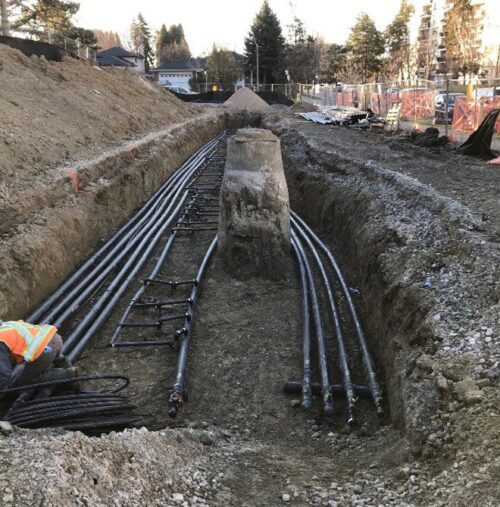New Geothermal GSHP Piping Systems Document Available

Parallel HDPE pipes installed as part of a buried geothermal header system. Photo courtesy of Geosource Energy Inc.
PPI Model Spec MS-7 Provides Up-To-Date Information
IRVING, Texas – The Plastics Pipe Institute, Inc. (PPI) has released a new Model Specification document that provides guidance to specifiers, engineers, designers, and others about selecting, specifying and installing plastic piping materials for ground source geothermal systems. Prepared by PPI’s Building & Construction Division, PPI MS-7 Model Specification for Plastic Piping Materials for Ground Source Geothermal Applications applies to plastic piping materials for open- and closed-loop, horizontal and vertical, direct-buried, and submerged water-based ground-source geothermal heat exchange systems.
PPI MS-7 includes detailed specifications for four plastic piping materials which have been proven in ground-source heat exchange systems: HDPE, PE-RT, PEX, and PP (PP-R and PP-RCT). According to PPI, the definitions, terms and other information can be readily used in bid documents, for example. The model specification provides language related to pipe and tubing materials, fittings, and joining procedures. Installation and pressure testing recommendations are also provided. It complements another PPI document, PPI TN-55 Plastic Piping Materials for Ground Source Geothermal Heating and Cooling Applications.
“High-density polyethylene (HDPE) has been the primary piping material used in geothermal ground loops for decades and is a proven resource for this application. The product standards and specifications for HDPE piping, however, have evolved in recent years, so a specifier that uses outdated language for piping systems may inadvertently specify a product that no longer exists in the market, or one that is simply less capable than the current state-of-the-art.” explained Lance MacNevin, P. Eng., director of engineering for PPI’s Building & Construction Division. “Also, two other types of HDPE-based piping materials, PEX and PE-RT, are now approved in model codes for geo ground loop and are important options for certain projects. In addition, PP-R and PP-RCT piping systems are recommended for indoor piping.”
Because geothermal systems significantly assist with decarbonization and deliver energy savings when heating and cooling buildings, this is the most exciting time in the geothermal industry in terms of market acceptance and new opportunities. Ground source heat pump systems are one of the most sustainable applications of plastic piping systems.
The team of experts from PPI member companies that developed MS-7 consulted with the latest model codes and standards from ASTM, CSA, IAPMO, ICC, IGSHPA, and NSF when developing the content. The new model spec also includes an entire section on Indoor Piping Products which are typically installed in mechanical rooms to connect the outdoor ground loops with heat pumps and hydronic distribution systems.
Additional information and data about piping materials used for both outdoor ground loop and indoor mechanical room piping materials is available from the PPI Building & Construction Division at www.plasticpipe.org/buildingconstruction.

The construction of large HDPE manifolds for a commercial geothermal system. The new PPI MS-7 provides detailed language for specifying both outdoor and indoor GSHP piping systems. Photo courtesy of Geosource Energy Inc.
About PPI:
The Plastics Pipe Institute, Inc. (PPI) is the major North American trade association representing the plastic pipe industry and is dedicated to promoting plastic as the materials of choice for pipe and conduit applications. PPI is the premier technical, engineering and industry knowledge resource publishing data for use in the development and design of plastic pipe and conduit systems. Additionally, PPI collaborates with industry organizations that set standards for manufacturing practices and installation methods.


